Mahboob Ali Khan
Asaf Jah VI Sir Mir Mahboob Ali Khan Siddiqi Bayafandi GCB GCSI (18 August 1866 – 29 August 1911) was the 6th Nizam of Hyderabad. He ruled Hyderabad state, one of the Princely states in India between 1869 and 1911.[1][2]
Lieutenant-General His Highness Rustam-i-Dauran, Arustu-i-Zaman, Wal Mamaluk, Asaf Jah VI, Muzaffar ul-Mamaluk, Nizam-ul-Mulk, Nizam ud-Daula, Nawab Sir Mir Mahbub Ali Khan Bahadur Sipah Salar, Fath Jang, Nizam of Hyderabad, GCB, GCSI | |
|---|---|
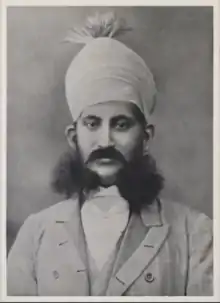 | |
| 6th Nizam of Hyderabad | |
| Reign | 26 February 1869 – 29 August 1911 |
| Predecessor | Afzal ad-Dawlah, Asaf Jah V |
| Successor | Mir Osman Ali Khan, Asaf Jah VII |
| Born | 18 August 1866 Purani Haveli, Hyderabad, Hyderabad State, British Indian Empire (now in Telangana State, India) |
| Died | 29 August 1911 (aged 45) Falaknuma Palace, Hyderabad, Hyderabad State, British Indian Empire (now in Telangana State, India) |
| Burial | |
| Spouse | Amat uz-Zehra Begum |
| House | Asaf Jahi dynasty |
| Father | Afzal ad-Dawlah, Asaf Jah V |
Early life

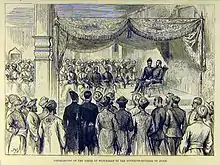
Mahboob Ali Khan was born on 17 August 1866 at Purani Haveli in Hyderabad, Hyderabad State (in present-day Telangana, India). He was the youngest son of Nizam Afzal-ud-Daulah. Afzal-ud-Daulah died on 28 February 1869. On 29 February, he ascended the throne under the regency of Dewan Salar Jung I and Shams-ul-Umra III. Mahboob Ali Khan was two years and seven months old at that time.[3] While Salar Jung I served as regent, Shams-ul-Umra III served as co-regent.[4]
Mahboob Ali Khan was the first Nizam to be exposed to western education. A special school under the guidance of Captain Claude Clerk was setup in the Chowmahalla Palace. The children of Salar Jung I, Shams-ul-Umra III and Kishen Pershad were his classmates. Besides English, he was also taught Persian, Arabic and Urdu languages. In 1874, Captain John Clerk, a former tutor to the Duke of Edinburgh was appointed to teach him English.[4] Clarke imbibed in " young Mahboob the customs and manners of high English society".[5]
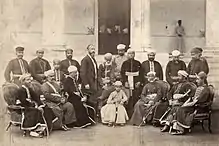
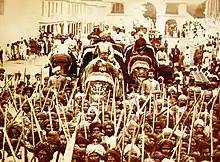
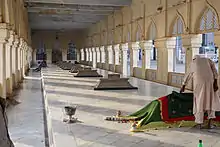
Reign
Investiture
At the age of sixteen, Salar Jung I began introducing Mahboob Ali Khan into the administrative processes of the state. The highest ranking officials of various departments would meet him to teach him the working of their respective departments.[6] The regency of Salar Jung I and Shams-ul-Umra ended when Mahboob Ali Khan came out of age. His investiture ceremony took place on 5 February 1884. Lord Ripon, the Governor-General of India was present at the ceremony and gifted him a golden sword which was studded with diamonds.[5] Mahboob Ali Khan took the title His Exalted Highness Asaf Jah, Muzaffar-ul-Mulk, Nawab Mahbub Ali Khan Bahadur, Fateh Jung.[7]
Development of a railway network
Nizam's Guaranteed State Railway - a railway company fully owned by the Nizams was established in 1879.[8] It was formed to connect Hyderabad State with the rest of British India, and was headquartered at Secunderabad Railway Station. Construction commenced in 1870. After four years of construction works, the Secunderabad-Wadi line was built. In 1879, Mahbub Ali Khan took over this railway line; it was then managed by the Nizam's state-owned railway.[9]
After independence, it was integrated into Indian Railways. The introduction of railways also marked the beginning of the industry in Hyderabad, and four factories were built to the south and east of the Hussain Sagar lake.[10]
Education development
Mahboob Ali Khan established Hyderabad medical college a first in India and commissioned for chloroform a first in world, during 1873 there were 14 Schools in Hyderabad city and 141 schools in rest of the districts, which reached upto 1000 at the time of his death.[11]
Flood of 1908
The Great Musi Flood of 1908 ravaged the city of Hyderabad.[12] It affected at least 200,000 people, killing an estimated 15,000. He opened his palace to accommodate the flood victims until "normal conditions were restored".[13][14][15][16]
Famine during his rule
The Great Famine of 1876-1878 occurred during his reign. The entire Deccan, including Hyderabad Deccan, was devastated by food shortages which were enormously exacerbated by British policies. The Nizam distributed aid to famine victims, causing tens of thousands of people to flee to Hyderabad from Sholapur and other affected areas.[17]
Abolishing practice of Sati
The practice of Sati where women used to jump into the burning pyre of their husbands concerned the Nizam. Taking serious note of Sati being continued in some parts of his kingdom despite the ban, he issued a Royal Firman[18] on 12 November 1876 stating:[19]
"It is now notified that if anybody takes any action in this direction in the future, they will have to face serious consequences. If Taluqdars, Naibs, Jagirdars, Zamindars and others are found careless and negligent in the matter, serious action will be taken against them by the government."
Personal life
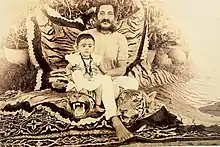
According to the Viceroy of India Lord Lytton; has a doubt that the object of the Diwan, Salar Jung I wanted to reduce Mir Mahboob Ali Khan to a cipher, in order to hold the power of the State and remain concentrated in his own hands.[20] The 6th Nizam had seven sons and seven daughters.
Lifestyle
The Nizam was well known for his extravagant lifestyle and collection of clothes and cars. His collection of clothes was one of the most extensive in the world at the time. He devoted a whole wing of his palace to his wardrobe and would never wear the same outfit twice. He bought the Jacob Diamond, which stands out among the Jewels of The Nizams now owned by the Government of India.
The Nizam was also fluent in Urdu, Telugu and Persian languages. He also wrote poems in Telugu and Urdu, some of which are inscribed alongside the walls of Tank Bund. He was a keen hunter,[21] killing at least 30 tigers.[22]
Marriage
He is married to Amat Uz Zahra Begum, daughter of Salar Jung I, with whom he fell in love while studding at the age of 18.[23][24]
Mystical powers
He claimed to possess a healing power against snakebites. It was his order that if anyone from the public had a snake bite, they could approach him. As a result, he was awakened from his sleep a number of times [25][26] to cure people of snakebites.[27]
Death
The 6th Nizam died on 29 August 1911 at the age of 45. He was buried alongside his ancestors at Mecca Masjid, Hyderabad. His second son Mir Osman Ali Khan succeeded him; he was the last Nizam of Hyderabad.[28]
Other names known by
Mahboob Ali Pasha
- He was better known as "Mahboob Ali Pasha" by the people.
Tees Maar khan
Mahboob Ali Khan was known as a skilled hunter. Many times people from nearby villages used to call for his help to kill tigers lurking in the nearby fields, thereby causing threat to lives of poor farmers. Hence he ended up killing at least 33 Tigers during his lifetime. He was popularly known to as "Tees Maar Khan" meaning the "Khan" who killed thirty"tees" (tigers).[29][21]
Full Titular name
- 1866–1869: Sahibzada Mir Mahbub Ali Khan Siddiqi Bahadur
- 1869–1877: His Highness Rustam-i-Dauran, Arustu-i-Zaman, Wal Mamaluk, Asaf Jah VI, Muzaffar ul-Mamaluk, Nizam ul-Mulk, Nizam ud-Daula, Nawab Mir Mahbub 'Ali Khan Bahadur, Sipah Salar, Fath Jang, Nizam of Hyderabad
- 1877–1884: His Highness Rustam-i-Dauran, Arustu-i-Zaman, Wal Mamaluk, Asaf Jah VI, Muzaffar ul-Mamaluk, Nizam ul-Mulk, Nizam ud-Daula, Nawab Mir Mahbub 'Ali Khan Siddiqi Bahadur, Sipah Salar, Fath Jang, Nizam of Hyderabad
- 1884–1902: His Highness Rustam-i-Dauran, Arustu-i-Zaman, Wal Mamaluk, Asaf Jah VI, Muzaffar ul-Mamaluk, Nizam ul-Mulk, Nizam ud-Daula, Nawab Sir Mir Mahbub 'Ali Khan Bahadur, Sipah Salar, Fath Jang, Nizam of Hyderabad, GCSI
- 1902–1910: His Highness Rustam-i-Dauran, Arustu-i-Zaman, Wal Mamaluk, Asaf Jah VI, Muzaffar ul-Mamaluk, Nizam ul-Mulk, Nizam ud-Daula, Nawab Sir Mir Mahboob 'Ali Khan Bahadur, Sipah Salar, Fath Jang, Nizam of Hyderabad, GCB, GCSI
- 1910–1911: Lieutenant-General His Highness Rustam-i-Dauran, Arustu-i-Zaman, Wal Mamaluk, Asaf Jah VI, Muzaffar ul-Mamaluk, Nizam ul-Mulk, Nizam ud-Daula, Nawab Mir Sir Mahbub 'Ali Khan Siddiqi Bahadur, Sipah Salar, Fath Jang, Nizam of Hyderabad, GCB, GCSI
Honours
(ribbon bar, as it would look today)
![]()
![]()
![]()
![]()
![]()
British honours
- Empress of India Gold Medal, 1877
- Knight Grand Commander of the Order of the Star of India (GCSI), 1884
- Honorary Knight Grand Cross of the Order of the Bath (GCB), 1902
- Delhi Durbar Gold Medal, 1903
Foreign honours
.svg.png.webp) Grand Cross of the Order of the Red Eagle, 1911
Grand Cross of the Order of the Red Eagle, 1911
See also
- Hyderabad State
- Nizam
- Category:Establishments in Hyderabad State
- Jewels of the Nizams
- Nizam College
References
- Law, Modern Hyderabad (Deccan) 1914, pp. 27-28.
- Balfour, The cyclopædia of India and of Eastern and Southern Asia, pp. 897.
- "A brief history of the Nizams of Hyderabad". Outlook. 5 August 2017. Retrieved 3 April 2019.
- Luther, p. 45.
- Seshan, K.S.S. (2 February 2017). "Mahboob Ali Pasha: Legend with a lavish lifestyle". The Hindu. Retrieved 3 April 2019.
- Lynton 1992, p. 34.
- M. Hassan (2002). HISTORY OF ISLAM (2 Vols. Set). Adam Publishers. p. 674. ISBN 9788174350190.
- Law, Modern Hyderabad (Deccan), pp. 26-28.
- Lynton, Days of the Beloved 1987, pp. 56-57.
- "Staying at Falaknuma is like holding a mirror up to our past". 16 September 2012.
- Bhangya, Bhukya (2013). "Between Tradition and Modernity: Nizams, Colonialism and Modernity in Hyderabad State". Economic and Political Weekly. 48 (48): 120–125. JSTOR 23528939.
- Lynton, The Days of the Beloved, pp. 13-20.
- "Seven Loaves - Seven Asaf Jahs".
- Siddique, Mohammed (29 September 2008). "Hyderabad observes 100th anniversary of Musi flood". Rediff. Retrieved 26 March 2020.
- Law, Modern Hyderabad (Deccan), pp. 84-86.
- "Hyderabad to observe 104th anniversary of Musi flood | The Siasat Daily". archive.siasat.com. 20 September 2012. Retrieved 31 July 2018.
- Davis, Mike. "Late Victorian Holocausts: El Niño Famines and the Making of the Third World". The New York Times. The New York Times Company. Retrieved 10 November 2018.
- "Letters leave a rich legacy of rulers".
- "Proclamation on the abolition of Sati issued by the Nizam VI, Mir Mahbub Ali Khan".
- Keen, Caroline (2003). "The power behind the throne: Relations between the British and the Indian states 1870-1909" (PDF). SOAS University of London: 82. Cite journal requires
|journal=(help) - "Hyderabad remembers 6th Nizam Mahbub Ali Pasha".
- "Staying at Falaknuma is like holding a mirror up to our past". 16 September 2012.
- "Journal of the Pakistan Historical Society, Volume 46, Issues 3-4". Pakistan Historical Society. 1998. Retrieved 28 July 2020. Cite journal requires
|journal=(help) - Zubaida Yazdani; Mary Chrystal (1985). The Seventh Nizam: The Fallen Empire. ISBN 9780951081907. Retrieved 28 July 2020.
- Lallana Rāya. Tulasī kī sāhitya-sādhanā: The Legacy of the Nizams. H.E.H The Nizam's Urdu Trust Hyderabad.
- "Picturing the 'Beloved'".
- Varma, Dr Raj. "Man of many talents". Telangana Today.
- Law, Modern Hyderabad (Deccan) 1914, pp. 28.
- "Hyderabad remembers Mahbub Ali Pasha". gulfnews. Retrieved 25 May 2018.
Further reading
- Lynton, Harriet Ronken; Rajan, Mohini (1974). The Days of the Beloved. University of California Press. ISBN 978-0-520-02442-7.
- Edward Balfour (1885). The cyclopædia of India and of Eastern and Southern Asia. B. Quaritch.
- Law, John (1914), Modern Hyderabad (Deccan), Thacker, Spink & Company
- Luther, Narendra (2003), Raja Deen Dayal: Prince of Photographers, Hyderabadi, ISBN 9788190175203
External links
Mahboob Ali Khan | ||
| Preceded by Afzal ad-Dawlah, Asaf Jah V |
Nizam of Hyderabad 1869–1911 |
Succeeded by Osman Ali Khan, Asaf Jah VII |
